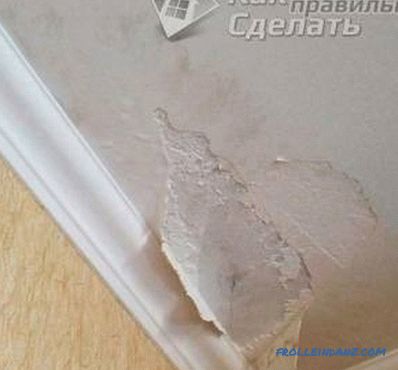For proper and efficient operation of your heating system, from time to time it is necessary to carry out maintenance work, such as inspection, repair, maintenance and flushing of the system. After all, if water is used as a coolant in the pipes, then over time, they form scum, rust and clogging. As a result, water circulates poorly, which leads to heat loss. It is verified that the heating system, which has not been washed for a long time, loses 10% in efficiency. Therefore, flushing should be a regular procedure. Washing the heating system with your own hands is possible. Let's figure out how to do it.
Why do you need washing
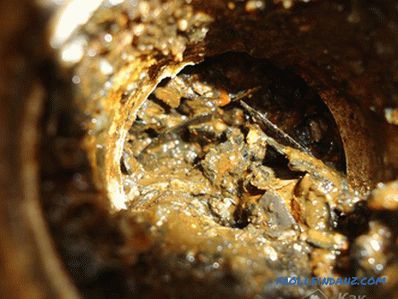 The radiators accumulate debris and rust
The radiators accumulate debris and rust
First A flush queue is needed to remove various debris and rust accumulated in radiators and pipes during operation. In the end, it turns out that the heating system is not functioning at 100%. You pay money for heat, but you do not get it in full. Moreover, we all know that scum is formed when water is heated, especially if it is water with impurities. This can be seen by looking at your kettle. If you have not cleaned it for a long time, then at the bottom you can notice a layer of scale. The same happens with pipes and radiators. Due to scale, the cross section of the pipe may be halved, which reduces the permeability of water in the system and its heat transfer (this applies to metal pipes).
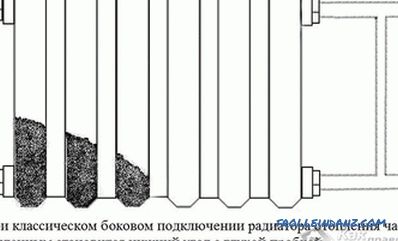 Often it is the lower corner that gets clogged up
Often it is the lower corner that gets clogged up
It is clear that your system needs to determine its appearance. flushing or not is impossible. But you just need to observe how the system works and take some action. So, to find out whether you need to flush pipes and radiators or not, you can by the following signs:
- The system warms up longer than usual.
- When the boiler is in operation, extraneous noises are heard that were not previously observed.
- The radiator heats up partially: it is warm from above, but not from below or the last ribs are cold.
- The radiator is absolutely cold, and the supply pipe is hot.
- Recently, the consumption of heat energy has increased, you began to pay more for gas.
All these signs will help you decide to flush pipes and radiators. Thanks to this, your heating system will improve.
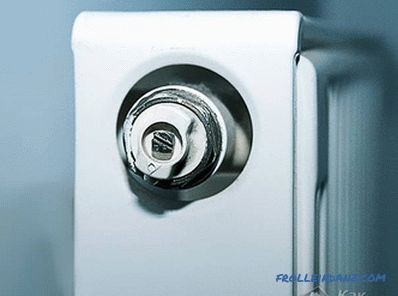 Sometimes it is necessary to bleed the air
Sometimes it is necessary to bleed the air
If the radiator is partially warming up, this is not always a sign of clogging system. Perhaps he is just a fool. In this case, you need to release the air from the radiator, using the taps Mayevsky.
Getting Started
When you are convinced that you really need to do the washing, you can begin to do it yourself. Such a procedure can not be called simple, so you have to make some effort and spend a lot of time. First you need to perform hydraulic flushing.
First of all, you need to shut off the water supply and drain it from the heating system. If you live in a high-rise building, you will have to go to the basement. Since it can be closed, provide access to it in advance. If you are a tenant of a private house, this procedure is easier to perform. Now disconnect the radiators from the pipes and remove them. It’s difficult to do it yourself, of course, if you are not Hercules, as the cast-iron radiators are quite heavy. So ask for help. If the connection does not work out, the coupling needs to be heated.
 Flushing the battery
Flushing the battery
After removing the battery, you can clean it by mechanical means. Further work in an apartment or house to perform inconvenient, since they consist in the use of a large amount of water. Put the radiator upside down, closing the hole that is below. Then use a hose to fill the battery with water. Then you need to release the water through the hole from the bottom, opening it. If the water literally "flew" out of the hole and carried away garbage and scum, you did everything right. The entire process must be repeated until the water that comes out of the battery is clean.
As the hot water moved along the radiator in one direction, the scale that it left formed in the form of scales. Turning over the radiator, you run the water in the opposite direction, which helps the water better remove all the scum. If this method is ineffective in your case, and there is still pollution, consider other cleaning options. They will help to cope with various pollution and to clean not only radiators, but also pipes.
Without removing the batteries
 Equipment
Equipment
Today types flushing the heating system is quite a lot. You can use each of them. Consider 5 different technologies for cleaning the heating system:
- Chemical washing.
- Dispersed rinsing.
- Electrohydropulse flushing.
- Hydropneumatic flushing.
- Pneumohydropulse flushing.
 Caustic soda is used
Caustic soda is used
Chemical washing is the use of special chemically active substances. This may be whey, caustic soda, vinegar, phosphoric, phosphoric and other acids, purchased in the store special compositions. The specificity of the washing system depends on the choice of means. If you will use a special composition, the instruction for work is written on the package. This sequence was developed by manufacturers, so it must be adhered to. If you use "improvised" reagents, they need to be poured into the system and once every 4 hours turn on the pump for 15 minutes. The procedure must be carried out for several days, after which the coolant is drained and the system is flushed several times. Dry cleaning is quite risky and is used for ferrous metals.
Dispersed washing is more gentle. A special reagent is introduced into the system, which acts exclusively on scale and debris, without interacting with the metal. This washing can be done for both metal and plastic pipes. The technology is quite simple and similar to a chemical one: a pump is connected to the system for circulation, a reagent is injected, which circulates through pipes and radiators, after which it is removed.
After this washing, the pipes are cleaned, and a protective hydrophobic film is formed on their walls - a “plastic pipe effect”, due to which salts do not settle on the surface.
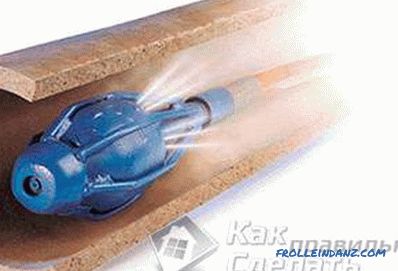 Hydropneumatic Flushing Hydropneumatic Flushing consists of breaking up contamination with a special flushing unit. It delivers thin jets of water and compressed air into the system under high pressure, which flushes out rust, scale and other deposits.
Hydropneumatic Flushing Hydropneumatic Flushing consists of breaking up contamination with a special flushing unit. It delivers thin jets of water and compressed air into the system under high pressure, which flushes out rust, scale and other deposits.
Pneumo-hydropulse flushing can be performed using a special impulse device or an air gun. The system is affected by multiple impulses that remove impurities. Thus, point cleaning of water pipes and radiators is provided. Used for Ø 150 mm, not more.
 Electrohydropulse equipment
Electrohydropulse equipment
Electrohydropulse cleaning is also performed using a special unit. The cleaning process consists in the fact that an electrical impulse is supplied to the pipe of the heating system through a coaxial cable. After that, at the end of the cable, an electrical discharge is formed, forming a powerful shock wave that acts on the scale, destroying it.
With such microexplosions, the pipes are not damaged or deformed. The main blow comes from pollution. At the end of cleaning, all trash needs to be washed from the system with running water.
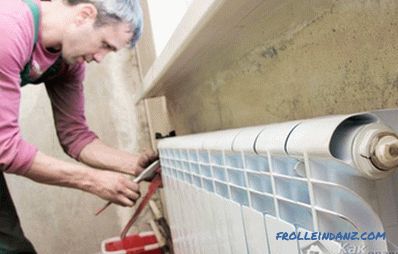 Cleaning the heating system requires
Cleaning the heating system requires
It is not just possible to do this cleaning of the heating system, but necessary! Such events should be held regularly. Thanks to this, you can significantly increase the permeability of water and heat transfer, which will save your money. The main thing is caution and following the rules. And to reduce the formation of scale in the pipes, you can install a special filter in front of the boiler that will clean the water circulating in the system.
Video
How to carry out the hydropneumatic flushing, see below:
See also:
Painting the radiators
How to disguise radiators
